
Known as the painter of “The Scream,” the Norwegian artist and his loved ones spent many years suffering from health conditions. A new exhibition explores how the world of medicine influenced his art

Andreas Munch Studying Anatomy, Edvard Munch, 1886
Juri Kobayashi / Munchmuseet
The Norwegian artist Edvard Munch was well-acquainted with the world of medicine. He was the son and brother of doctors, and he suffered from medical and psychiatric illnesses throughout his lifetime. These experiences informed his depictions of ailing bodies and minds.
“Lifeblood: Edvard Munch,” a new exhibition at the Munch Museum in Oslo, explores Munch’s fascination with illness through paintings and artifacts. The show examines not only the artist’s life, but also the history of medicine in the late-19th and early-20th centuries.
Quick facts: Why did Edvard Munch paint The Scream?
- The painting was inspired by a walk the artist took with two friends in 1882.
- “My friends walked on, and I stood there trembling with anxiety—and I sensed an infinite scream passing through nature,” he later wrote.
“[The show] allows visitors to explore the history of healthcare through Munch’s powerfully expressive work, to feel and reflect on our bodily vulnerabilities, and to better understand our persistent quest for health,” says exhibition curator Allison Morehead, an art historian at Queen’s University in Canada, in a statement from the museum.
Born in Norway in 1863, Munch is known for his paintings that explore psychological themes, such as The Scream. But some of his earliest artworks depict mundane medical matters. He spent much of childhood in poor health, and he sometimes ran errands for his father, who was a doctor. When he was a young teenager, he painted small watercolors of medicine bottles, some of which are included in “Lifeblood.”
Munch’s loved ones were also plagued by illness, which provoked his fear—and inspired his art. As Mai Britt Guleng, a curator at the National Museum in Oslo, told Scientific American’s Jan Dönges in 2021, “There [were] hereditary diseases in Munch’s family—mental, nervous illness and tuberculosis. … Munch and his siblings were worried about this.”
Medicine Bottle and Spoon, Edvard Munch, 1877 Tone Margrethe Gauden / Munchmuseet/https://tf-cmsv2-smithsonianmag-media.s3.amazonaws.com/filer_public/c9/a9/c9a9b9ae-5658-44a5-9db5-5de1ec521552/medisinflaske_og_skje.jpeg)
Munch’s father struggled with depression, and his sister Laura spent time in a psychiatric ward. Meanwhile, his mother died of tuberculosis when he was 5, and his older sister Sophie perished from the same disease when he was 14. His sister’s death inspired his 1886 portrait The Sick Child, which depicts a pale girl with red hair. Munch’s brother Andreas also died of pneumonia as an adult.
In 1919, Munch was 56 when he contracted the Spanish flu, which was ravaging Europe. During this period of illness, the artist painted Self-Portrait With Spanish Flu, which shows Munch staring toward the viewer, struggling to breathe. In the exhibition, this painting is displayed beside the equipment Munch used to help him breathe during his illness.
Edvard Munch’s Self-Portrait With Spanish Flu (1919) alongside breathing equipment the artist used during his illness Ove Kvavik / Munchmuseet/https://tf-cmsv2-smithsonianmag-media.s3.amazonaws.com/filer_public/fb/41/fb41ad51-65cd-45e1-8188-52ab8e9ab302/livsblod-11_1.jpeg)
Also on display is a piece called On the Operating Table, which depicts a man surrounded by doctors, nurses and an audience of observers during surgery. This painting is connected to a violent encounter between Munch and his fiancée in 1902, which left him with a bullet wound in his hand. According to the Art Newspaper’s Louisa Buck, experts aren’t sure who fired the shot, but the surgery he endured afterwards inspired the piece.
The exhibition displays On the Operating Table beside an X-ray image of Munch’s hand—a new technology at the time—in which a bullet can be seen in his finger. Other medical artifacts on view include glass sputum bottles, a baby incubator, stethoscopes, a nursing uniform and contraceptive devices.
On the Operating Table, Edvard Munch, 1902-03 Juri Kobayashi / Munchmuseet/https://tf-cmsv2-smithsonianmag-media.s3.amazonaws.com/filer_public/01/5e/015ec1f7-3bad-4685-967e-8ba72c9bf7da/pa_operasjonsbordet.jpeg)
Munch’s work often reflected women’s health concerns, such as “melancholy, hysteria, syphilis, contraception, childbirth and infant care,” per the statement. Consider his painting Inheritance (1897-99), which depicts a coughing mother holding a sickly newborn. It was inspired by Munch’s visit to a Paris syphilis hospital, where he recalled watching a mother learn that her baby had been infected with the disease, according to the Art Newspaper.
“‘Lifeblood’ reveals a lesser-known side of Edvard Munch—where art becomes a vessel for the fears, hopes and compassion that surround illness and care,” museum director Tone Hansen says in the statement. “By intertwining Munch’s work with the history of medicine, this exhibition invites us to reflect on our own health and vulnerability in a time of deep uncertainty.”
“Lifeblood: Edvard Munch” is on view at the Munch Museum in Oslo through September 21, 2025.

/https://tf-cmsv2-smithsonianmag-media.s3.amazonaws.com/accounts/headshot/Sonja_headshot.png)






